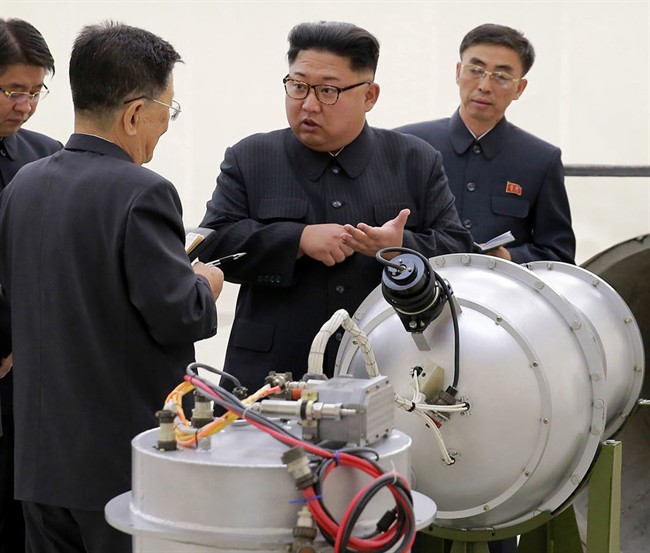It’s hard at times to avoid falling into the trap of feeling like you’re living in some sort of ’80s nostalgia theme party.

The Russians are back — in that they’re bad and scary again. There’s U.S. and Canadian troops in Europe, standing in their way. U.S. states and territories are updating their civil defence plans in case of nuclear attack. Newspapers (well, OK, news websites — some things have changed since the ’80s) are running explainer pieces, with headlines like, “Can a ballistic missile hit North America?” and “What’s the difference between an atomic bomb and a hydrogen bomb?”
We can blame a lot of this on North Korea’s recent provocations, of course, which include continued missile tests and the detonation of an apparent hydrogen bomb (OK, fine, I’ll explain: a more advanced, and potentially much more powerful, weapon than a “mere” atomic bomb). And certainly concerns over Iran’s nuclear program and Russia’s aggressive manoeuvring in parts of the world have also raised awareness of these issues. That’s natural and unobjectionable.
But what’s not understandable, and is really quite shameful, is how little appreciation the public has of nuclear weapons. I don’t mean the technical specifics of them, or the nitty gritty details of how a Minuteman missile compares to a Trident. That’s stuff for professionals and interested amateurs, such as myself. I’m talking just even the slightest awareness of the fact that the weapons and our reliance on them for much of our global security system didn’t just go away at the end of the Cold War. They’re still there. The threat backed off some after 1991, but it has never gone away.
It’s strange to think this, but as you read these words, scattered across the American heartland in hardened command posts deep underground, men sit, in teams of two, in missile launch complexes, waiting for firing orders that will hopefully never come. They have their opposites in Russia and China. Similarly, right now, all over the world, beneath the waves, crews of ballistic missile submarines are quietly cruising the world’s oceans, hidden from sight and desperately hoping to stay that way. Their only job is to survive a sudden nuclear attack on their homelands so that they can retaliate with a devastating barrage of nuclear warheads, in hopes that no enemy will dare launch such an attack for fear of that retaliation.
The Cold War ended, but these long deterrence patrols never did. The submarines are still out there. The missiles are still in their silos. In at least nine nations, crews practice unleashing these ultimate weapons on their national enemies, either to cripple or retaliate. The number of warheads has dropped since 1991, but there’s more than enough still out there to make an awful mess of our little civilization. Not that we think much about that.
Did we get used to the mortal danger? It’s possible. Anything, no matter how strange or horrific, can become routine if given enough time. But I tend to think the explanation is simpler: for most people, nuclear weapons are inextricably linked to the Cold War. When the Cold War ended, we stopped thinking about it, and the nukes, too. They never went away, but we allowed ourselves to believe they did, even though we really ought to know better.

Get daily National news
I’m not an alarmist. I’m not converting my basement into a fallout shelter (though I at least know what fallout is and how to try and protect yourself from it). It’s still unlikely that we’ll see a nuclear exchange, or even credible threats of one, any time soon. The situation with North Korea is alarming, and I worry about their young crackpot overlord and the competency of the U.S. president, but I think both sides, ultimately, will want to avoid a confrontation that neither would truly “win.”
But our vacation from history seems to be ending. Great power politics, including nuclear brinksmanship, are something we’re going to have to learn to expect again. The Western public is going to need to do its part — learning at least the rough outline of how our international order holds together, including the role of deterrence and alliances. That kind of information is essential to forming useful opinions that may serve to guide our elected leaders — that’s the point of a democracy, after all.
During the Cold War, the public had some baseline knowledge of these things. I’m not wearing rose-coloured glasses, there are simplistic dolts in any era, but at least the public in aggregate could form grasp what was at stake and the consequences of changes and emerging threats. We need to get that back.
So yes, read the explainer pieces. Familiarize yourselves with the basic concepts at play, including deterrence and mutually assured destruction. Read up on the weapons, what they can do and how they’d be used. Come to understand what radiation is and why it complicates any possible use of a nuclear weapon.
And let’s never make the mistake of forgetting this stuff again. The world can be a scary place, but ignorance doesn’t make any of us safer. Rather the opposite, in fact.
Matt Gurney is host of The Morning Show on Toronto’s Talk Radio AM640 and a columnist for Global News.


















Comments